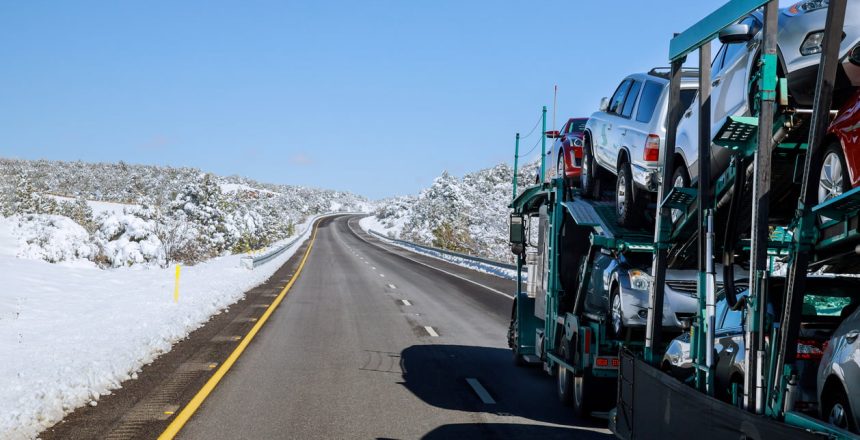Winter vehicle shipping brings unique challenges but following a few tips can eliminate many potential problems.
Key takeaways
- Winter vehicle shipping brings challenges
- Creating a plan eliminates many problems
- Mercury Auto Transport can help find a reputable carrier
Moving a vehicle from point A to point B isn’t always as simple as it seems. Sure, you could drive the car to its destination, but you might not have the time to make the journey. Contracting an auto transport carrier service is your best bet because to ensure that your car gets where it needs to be without the hassle of driving.
Shipping a vehicle in the winter months brings an entirely new set of challenges. Still, by developing a plan, preparing the vehicle for transport, and speaking with reputable shippers, you can ensure the process runs smoothly and your vehicle gets to its destination without hassle or damage.
1. Choose the right carrier
Finding the right carrier is a vital part of shipping any vehicle in the winter, especially because road conditions can throw other variables at you.
Start by going over multiple carrier’s timeline estimates. While the vehicle shipping industry generally doesn’t offer guarantees on delivery dates, you can usually negotiate a range of dates when the car should arrive.
So, while you can’t say you need the car to arrive on a specific date, it’s possible to ask for the delivery to come around a particular day, at least within reason.
Keep in mind that road conditions can make it challenging or even impossible for the vehicle to arrive at a specific location in a hurry. For example, a snowstorm can close roads or make certain parts of the country inaccessible. Your carrier should have a plan to address these issues and stay in communication with you.
It’s also worth remembering that winter road conditions include sand and other abrasive ice-melting solutions on the roadways. Small rocks often end up in this sand and can damage windshields.
Elements like these are always a risk to damage your vehicle as it sits on an open transport carrier. That’s why it’s a good idea to select a closed auto transport when shipping your car, but that option will cost more.
It’s up to you to decide whether shipping your vehicle inside a trailer is worth the additional expense. You’ll also want to inquire about insurance in case the car encounters damage during transportation.
Flatbed transport is available, too, if your vehicle won’t fit on regular car transports. It’s the most expensive option and takes the most effort to arrange, but it may be the only option for unusual vehicles.
Every carrier will have different offerings, so plan to put some effort into finding the one that best meets your needs. As a rule, always select a carrier that is compliant with FMCSA regulations.
2. Plan the shipment
Winter is a strange time in the car shipping industry because its volume varies month by month. For example, the first week of January is hectic, often with twice as many requests for shipments as available capacity. Demand drops in the second and third weeks of January before finally returning to normal by the end of the month.
At the same time, February and March are far less busy than the summer, as are the last couple of weeks in December.
One reason for this inconsistency is that people want to spend the holidays with their families. Therefore, many snowbirds (people who spend the winter months in sunnier Southern climes) won’t head south until after Christmas and need their car shipments to coincide with when they finally leave town.
Prepare for higher costs if January vehicle shipping is necessary because there’s a great deal of demand. Even finding a willing carrier takes a bit of luck.
Likewise, there are lower than average costs in December, February, and March.
Have clear expectations for what your winter enclosed auto transport will cost so you don’t end up disappointed.
Read our article “Best Time of the Year to Ship Your Car” for further insights.
3. Get the car ready for shipment
Before loading your vehicle onto a truck for shipping, there are a few things you’ll need to do in preparation.
For starters, regardless of the season, you should clean the car inside and out. Remove any valuables that don’t need to be there, secure loose parts, and order a second set of keys if you don’t already have one.
It’s also a good idea to take pictures of any vehicle damage present, pre-emptively take it to the mechanic and log your mileage.
Remember that your car should have less than a quarter tank of gas when shipping, too.
You can make some additional preparations in the winter, including topping the radiator off with antifreeze, inspecting your car’s belts, which should be part of your mechanic visit, and adjusting the tire pressure.
Tire pressure changes with the weather, so starting with lower pressure is advisable if your car is heading to a warmer destination.
The better you prepare your vehicle before shipping it to a new destination, the less work you’ll have once it arrives.
Finding a shipping carrier
Choosing between shipping carriers is often overwhelming because there are so many options available. This issue becomes even more pronounced in winter because capacity can vary week-to-week and extreme weather conditions may slow deliveries significantly.
The good news is that Mercury Auto Transport is available to match you with the exact auto transport carrier to meet your needs. We only work with licensed carriers, ensuring your vehicle is safe and the service is reputable. Contact us to learn more or receive your free quote.






